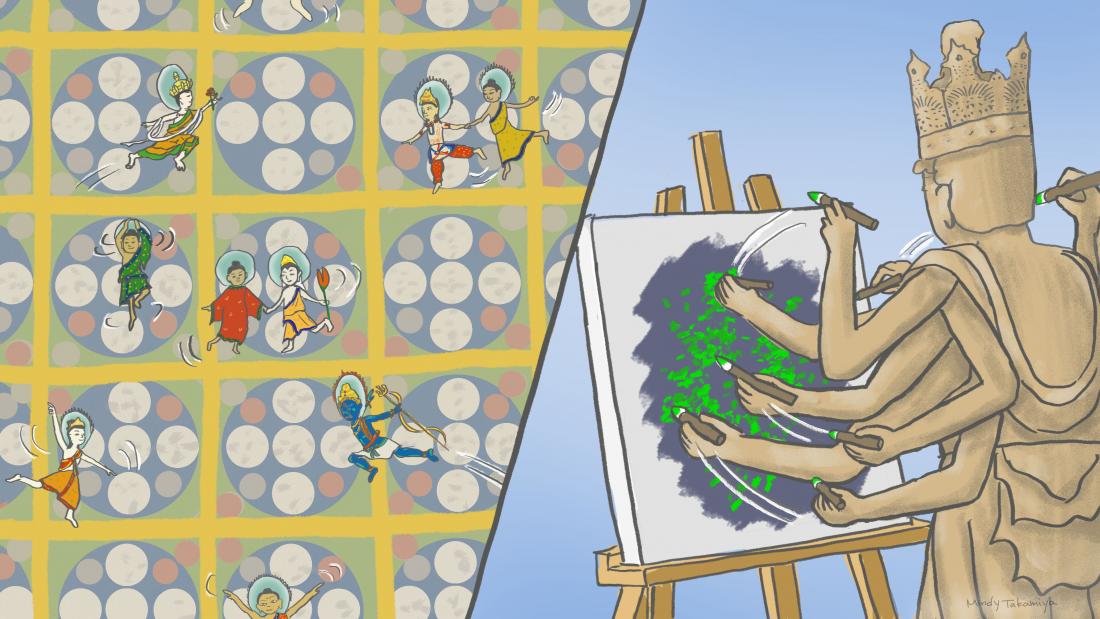(Left) The ultrafast camera revealed molecules in the cell membrane (represented by various buddhas) appearing to dance within spaces bound by actin filaments (represented by the mandalas) and occasionally jumping over the boundaries.
(Right) Pairing the ultrafast camera with SFMI allows the creation of pointillism-like images 60 times faster than previous methods.
Researchers at Kyoto University, Okinawa Institute of Science and Technology Graduate University (OIST), and Photron Limited in Japan have developed the world’s fastest camera capable of detecting fluorescence from single molecules. They describe the technology and examples of its power in two articles published in the same issue of the Journal of Cell Biology.
“Our work with this camera will help scientists understand how cancer spreads and help develop new drugs for treating cancer,” says bio-imaging expert Takahiro Fujiwara, who led the research at the Institute for Integrated Cell-Material Sciences (iCeMS).
Single fluorescent-molecule imaging (SFMI) uses a fluorescent molecule as a reporter tag that can bind to molecules of interest in a cell and reveal where they are and how they are moving and binding to each other. The team’s ultra-fast camera allows the highest resolution in time ever achieved by SFMI. It can detect single molecule movements that are 1,000 times faster than the normal video frame rate. Specifically, it can detect a molecule with an attached fluorescent tag every 33 microseconds with 34 nanometre precision in position, or every 100 microseconds at 20 nanometre precision.
“We can now observe how individual molecules dance within living cells, as if we are watching a ballet performance in a theatre,” says Fujiwara. He emphasises that previous SFMI techniques were like watching the ballet once every 30 seconds, so the audience had to guess the story from such sparse observations. It was extremely difficult and the guesses were often entirely wrong.
Furthermore, the ultrafast camera that the team developed tremendously improved the time resolution of a previous super spatial resolution method, which was recognized with the Nobel award in Chemistry in 2014. In this earlier method, the positions of individual molecules are recorded as small dots of approximately 20 nm, forming images like the pointillism paintings by the new impressionists, led by Georges Seurat. However, the problem of the pointillism under the microscope has been that the image formation is extremely slow and it often takes more than 10 minutes to obtain a single image, and thus the specimens had to be chemically fixed dead cells. With the developed ultrafast camera, the image can be formed in 10 seconds, about 60 times faster, allowing observations of live cells.
The team further demonstrated the power of their camera by examining the localization and movement of a receptor protein involved in cancers and a cellular structure called the focal adhesion. The focal adhesion is a complex of protein molecules that connects bundles of structural proteins inside cells to the material outside cells called the extracellular matrix. It can play a significant role in the cellular mechanical interactions with its environment, allowing cancer cells to move and metastasize.
“In one investigation we found that a cancer-promoting receptor that binds to signalling molecules is confined within a specific cellular compartment for a longer time when it is activated. In another, we revealed ultrafine structures and molecular movements within the focal adhesion that are involved in cancer cell activities,” says Akihiro Kusumi, the corresponding author, who is a professor at OIST and professor emeritus of Kyoto University. The results allowed the team to propose a refined model of focal adhesion structure and activity.
Many research teams worldwide are interested in developing drugs that can interfere with the role of focal adhesions in cancer. The ultrafast camera developed by the team in collaboration with Mr. Takeuchi of Photron Limited, a camera manufacturer in Japan, will assist these efforts by revealing deeper understanding of how these structures move and interact with other structures inside and outside of cells.
###
Papers:
“Development of ultrafast camera-based single fluorescent-molecule imaging for cell biology”
Journal of Cell Biology|https://doi.org/10.1083/jcb.202110160
“Ultrafast single-molecule imaging reveals focal adhesion nano-architecture and molecular dynamics”
Journal of Cell Biology|https://doi.org/10.1083/jcb.202110162
About Kyoto University’s Institute for Integrated Cell-Material Sciences (iCeMS):
At iCeMS, our mission is to explore the secrets of life by creating compounds to control cells, and further down the road to create life-inspired materials.
https://www.icems.kyoto-u.ac.jp/
For more information, contact:
Christopher Monahan / I. Mindy Takamiya
[email protected]



